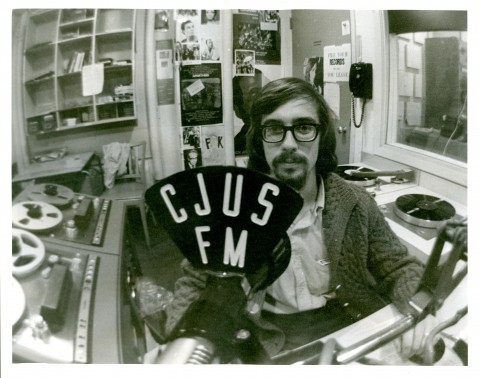For long-time listeners of CFCR 90.5 FM, fall is almost synonymous with the FM-Phasis Fundraising Drive. Starting on Sept. 30 and persisting until Oct. 13, CFCR looks to the City of Saskatoon for assistance with one of the station’s most important forms of revenue.
However, even seasoned listeners may not be aware that such community centredness has been at the heart of the station since day one.

Eons ago — in earlier, more idealistic times — the University of Saskatchewan had its own campus radio station. CJUS-FM, which was briefly rebranded as CHSK-FM, began on campus in 1965 in the basement of the Memorial Union Building, where Louis’ Pub now resides. However, the college station signed off for the last time in September 1985 due to budget cuts.
Despite this, a group of determined student hosts fought hard for the station’s survival.
Like a phoenix reborn from the ashes, CFCR 90.5 FM rose out of the demise of the U of S station in 1991. Now, 26 years since the first host signed on, CFCR transmits no signals of slowing down anytime soon.
The station boasts that over 100 volunteers sift through its doors a week. They have more than 500 members and six full-time employees. Though the complexion of CFCR has certainly changed, it still remains a community-run initiative. As one of the few non-profit radio stations in Saskatoon, CFCR relies upon community support in order to survive — and this is where the FM-Phasis fundraising drive comes in.
Neil Bergen, who has been manager of the station since 2006 and a volunteer host since 2000, spoke to the Sheaf about FM-Phasis, the importance of community and the persisting legacy of radio as a media form.
Bergen told the Sheaf that FM-Phasis accounts for nearly 20 per cent of the station’s $450,000 budget, and the funding goal for this year’s drive is $70,000. The remainder of the budget is gained through the station-run bingo nights and through ad revenue — all of which, as Bergen reveals, is raised internally.
“We are pretty much self-sufficient. We have been very fortunate that the [Saskatchewan] Arts Board gives us a [$20,000] grant every year, as an arts organization,” Bergen said.
Aside from the small grant from the Arts Board, CFCR receives no external support — neither the provincial government nor the City of Saskatoon provide financial assistance. Bergen surmises that the reason for this is because community radio stations hold a unique place as an organization.
“For many years, we never qualified for any grants. When [grant-givers] saw that we are a radio station, we were out immediately, because we’re so different from everything else. We’re not a charity, not food bank, not a liver foundation. We’re an unusual entity,” Bergen said.
Certainly, financial assistance from the provincial government and the city would be welcomed, but Bergen nevertheless counts the lack of external assistance as a blessing.
“We are very lucky that we are self-sufficient. We don’t rely on anyone else. When your funding gets cut, you’re pretty much out of business. We have a very strong core of listeners who have supported this station since day one,” Bergen said. “There are people who have been donating to this station every year for 25 years. That’s really what has kept this place going — the core volunteers and the core listeners who have been donating every year.”

Ken Gordon, student director of CJUS-FM, in 1968.
Bergen notes that funds raised from FM-Phasis will go to renewing and maintaining integral parts of the station.
“Equipment is a big thing — simple things like CD players, which we still use, are getting more expensive and less well-made every year. We go through them like crazy now. We’re still putting aside money for a new board in the studio — that’s going to be a big-ticket item. That’ll be around $20,000,” Bergen said.
The funds raised will also go to more run-of-the-mill operations at the station, like power bills, as the station’s transmitter alone costs $800 a month for power.
As always, those who donate to FM-Phasis will receive merchandise and can be entered in up to three grand-prize giveaways. The type of merchandise given is dependent on the amount donated — amounts are broken up into $10, $25, $75, $150 and $250 tiers. Some of the items include magnets, the FM-Phasis Low Emission Transmission T-shirts and CFCR pint glasses.
The grand-prize draws include an $800 shopping spree to Doug’s Spoke ’N Sport, a pair of custom shoes from cordwainer extraordinaire Last Shoes and a painting by local artist Hugo Alvarado. The complete list of items can be found at cfcr.ca.
For the first time ever, CFCR is offering a monthly debiting system for those who want to give a larger donation. This means that the $150 donation would cost the donor $12.50 a month for the year, a number that Bergen points out is only slightly higher than what people pay for Netflix every month.
Recognizing the precarious economic situation that many students find themselves in — and also the apprehension that goes with donating what little money they have — Bergen is adamant that any amount helps.
“A $5 donation means something as well — any amount is welcome. Our average donation is $25. We don’t get huge donations, we don’t have anyone giving us thousands of dollars — it would be pretty nice if we did — but we raise that $70,000 dollars on $25 donations. We get over 1,000 donations, and the majority of them are $25. Any amount is more than appreciated,” Bergen said.
In addition to a treasure trove of appreciative items, there are several shows across Saskatoon during the two weeks of FM-Phasis. Some of the bigger shows include folk crooner Lisa LeBlanc at the Capitol Music Club on Sept. 29 and Regina rockers Library Voices at Amigos Cantina on Oct. 6. CFCR will have booths set up during these shows, so donors can contribute while listening to good tunes. As with the prizes, the full list of concerts can be found at cfcr.ca.
While prizes and good times are always nice, Jordan Stovra, a third-year history major at the U of S and Monday host for CFCR’s the Buzz, believes that there are benefits to donating to FM-Phasis beyond the material prizes and the concerts.
“It’s important to donate to FM-Phasis for two reasons. [The first is that] CFCR supports the community in a bunch of ways, like providing minority groups their own shows. [The second is that it] provides opportunities for unique voices to be heard across the airwaves of Saskatoon,” Stovra said.
For Bergen, this focus on supporting lesser-represented community members is one of CFCR’s central aims.
“Our mandate is to give a voice to under-represented groups and organizations — and music for that matter. These opportunities aren’t available in commercial radio,” Bergen said. “We are the one place where anyone who is in a non-profit situation can come [to] get their word out. We are here to represent the unrepresented, to give [them] a voice on the public airwaves, because the public airwaves are very hard to get on.”
In addition to being an important communicative tool for communities in Saskatoon, Bergen believes that CFCR is unique in comparison to commercial radio stations in the city.
“[CFCR] is what radio was like in the ’50s, where you had individuals doing their own show, playing the music they liked and playing different types of music. This is what music used to be like — it didn’t used to be the same stuff all day long. It was different every couple of hours, when a new person came on and did a show. I think this is one of the huge differences between us and anybody else. Having worked in commercial radio for over 20 years, [community radio] is so much better.”
Bergen is also optimistic about the longevity of radio, especially considering the decline of other media sources like print and cable.
“I think that radio has … one big advantage over any other form of media, including the internet, and that is that you can go about your daily life — do everything that you would normally do in a day — and listen to radio,” Bergen said. “You can’t do that with any other media.
“You can’t do that with print media, you can’t do that with television, you can’t even do it with the internet, because your focus has to be on exactly what you’re looking at, whereas in radio, you can have it on while you’re driving, at work and when you’re studying. You can have your radio on whenever you want, and it doesn’t interfere with what’s going on in your life.”
To learn more about CFCR and anything related to the FM-Phasis funding drive, head on over to cfcr.ca or stop by their headquarters on the third floor of 267 Third Avenue South.
—
Tanner Bayne / Culture Editor
Graphic: Lesia Karalash / Graphics Editor
Photo: University of Saskatchewan, University Archives & Special Collections, Photograph Collection, A-10707